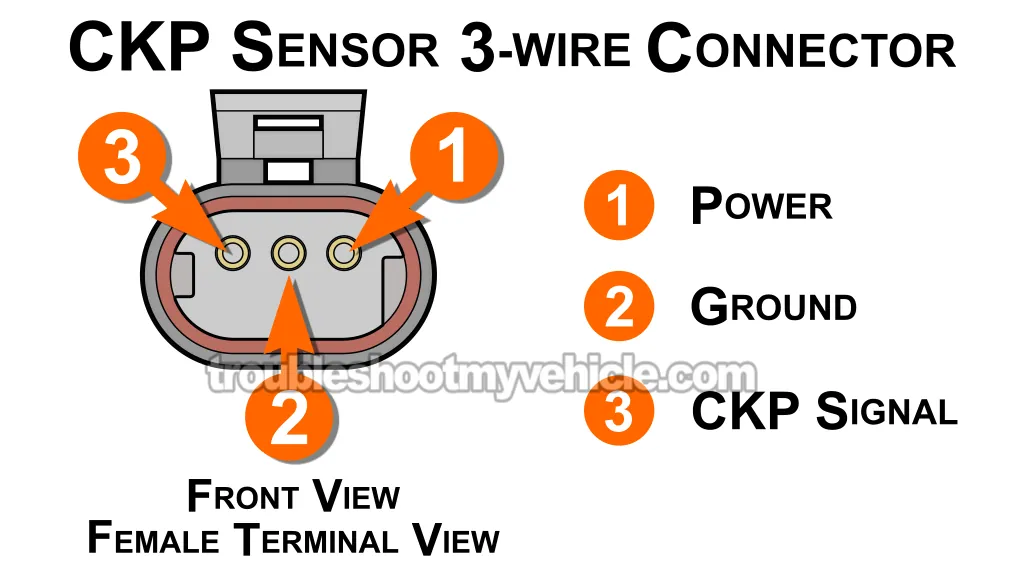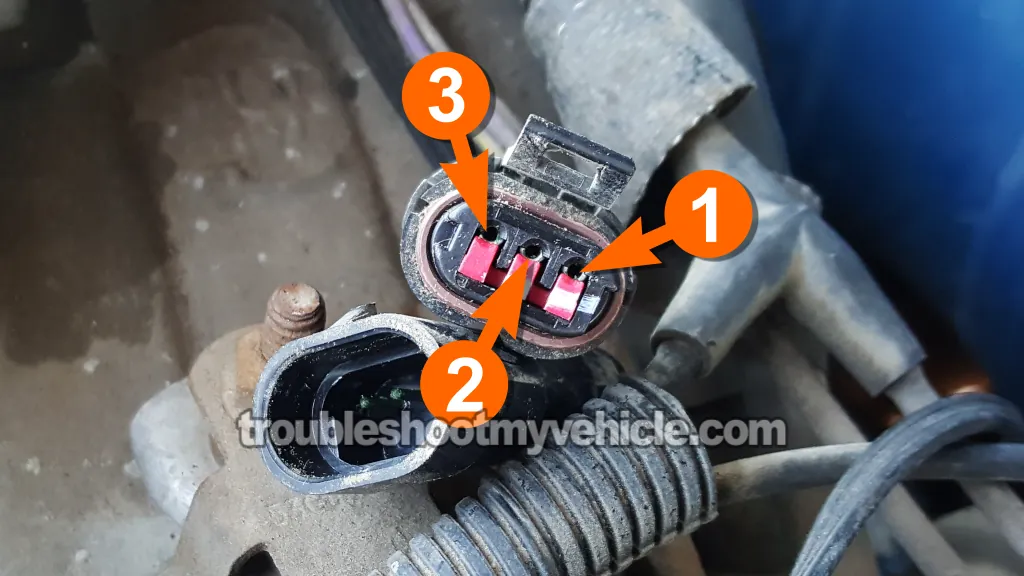
The crankshaft position (CKP) sensor is a key piece of the ignition system that your V8 Dodge Ram pickup's PCM counts on to start and keep the engine running.
When this little guy goes bad, you're gonna be stuck with the engine cranking, but not starting.
The good news? Testing the CKP sensor is a pretty simple affair, and it's all done using just a multimeter. In this tutorial, I'll walk you through the whole testing process, step-by-step.
Contents of this tutorial:
- Important Tips And Suggestions.
- How The CKP Sensor Works.
- CKP Sensor Connector Pinout.
- Where To Buy The CKP Sensor And Save.
- TEST 1: Checking The CKP Signal With A Multimeter.
- TEST 2: Making Sure The CKP Sensor Has Power.
- TEST 3: Making Sure The CKP Sensor Has Ground.
- More 5.2L, 5.9L V8 Dodge Ram Pickup Tutorials.
APPLIES TO: This tutorial applies to the following vehicles:
1992-1993:
- Dodge Ram 150 Pickup 5.2L V8: 1992, 1993.
- Dodge Ram 250 Pickup 5.2L V8: 1992, 1993.
- Dodge Ram 150 Pickup 5.9L V8: 1992, 1993.
- Dodge Ram 250 Pickup 5.9L V8: 1992, 1993.
- Dodge Ram 350 Pickup 5.9L V8: 1992, 1993.
1994-1997:
- Dodge Ram 1500 Pickup 5.2L V8: 1994, 1995, 1996, 1997.
- Dodge Ram 2500 Pickup 5.2L V8: 1994, 1995, 1996, 1997.
- Dodge Ram 1500 Pickup 5.9L V8: 1994, 1995, 1996, 1997.
- Dodge Ram 2500 Pickup 5.9L V8: 1994, 1995, 1996, 1997.
- Dodge Ram 3500 Pickup 5.9L V8: 1994, 1995, 1996, 1997.
WIRING DIAGRAMS:
- Ignition System Wiring Diagram (1992 5.2L, 5.9L V8 Dodge Ram Pickup).
- Ignition System Wiring Diagram (1993 5.2L, 5.9L V8 Dodge Ram Pickup).
- Ignition System Wiring Diagram (1994-1995 5.2L, 5.9L V8 Dodge Ram Pickup).
- Ignition System Wiring Diagram (1996-1997 5.2L, 5.9L V8 Dodge Ram Pickup).
IGNITION SYSTEM TESTS:
- How To Test The Ignition Coil (1992-2003 5.2L, 5.9L V8 Dodge Ram Pickup).
- How To Test The Camshaft Position Sensor (1992-1995 5.2L, 5.9L V8 Dodge Ram Pickup).
- How To Test The Camshaft Position Sensor (1996-1997 5.2L, 5.9L V8 Dodge Ram Pickup).
ENGINE NO-START TESTS:
Important Tips And Suggestions
TIP 1 →On-Car Test: The CKP sensor check I'm about to show you happens with the sensor still mounted on the transmission's bell housing. No need to pull it out to run this test.
TIP 2 →Turn the engine by hand (not with the starter motor): To get a super accurate test result that'll tell you if the sensor is OK or bad, you're gonna need to crank the engine by hand.
This is really important —if you use the starter motor to spin the engine, your reading won't be reliable.
When I say crank it by hand, I mean using a 1/2-inch ratchet wrench and the right socket on the crank pulley to turn the engine over manually.
TIP 3 →Always check for spark first: Here's something critical to remember: if you've already checked for spark and you're seeing spark on your V8 Dodge Ram pickup, then your CKP sensor is working fine.
A good spark means the CKP sensor is doing exactly what it's supposed to. If that's the case (you're getting spark), running this CKP sensor test won't tell you anything useful.
This tutorial will help you check for spark:
How The CKP Sensor Works

The crankshaft position sensor (CKP) is located on the transmission bell housing. From there, it reads notches on the flywheel as the engine cranks or runs.
- CKP signal: The flywheel has 8 notches spaced 45° apart. As they pass under the CKP sensor, 8 pulses are produced per engine revolution and sent to the fuel injection computer.
- Purpose: The CKP signal helps the computer figure out crankshaft position and engine speed (RPM). It combines this info with the CMP sensor signal to control spark and fuel injection timing.
- No CKP signal, no-start: If the computer doesn't detect the CKP sensor pulses, it shuts off the Auto Shutdown (ASD) relay and the fuel pump relay. This kills power to the fuel injectors and ignition coil, and the engine won't start.
- ON/OFF voltage: As the engine turns, the CKP sensor creates an ON/OFF signal. "ON" is when the voltage reads 5 Volts DC, and "OFF" is when it drops to 0 Volts.
- Testing: The cool thing is that we can see this 5V-0V switching with a multimeter — and that's exactly how we're gonna' test it.
CKP Sensor Connector Pinout

| Pin | Wire Color | Description |
|---|---|---|
| 1 | Orange (ORG) | 8 Volts DC →1992-1995 only |
| Violet with white stripe (VIO/WHT) | 5 Volts DC →1996-1997 only | |
| 2 | Black with light blue stripe (BLK/LT BLU) | Sensor Ground |
| 3 | Grey with black stripe (GRY/BLK) | CKP Signal |
Where To Buy The CKP Sensor And Save
If you're not sure if the above CKP sensors fit your particular vehicle, don't worry. Once you get to the site, they'll make sure that it fits and if it doesn't, they'll ask the particulars of your specific Dodge to find you the right one.
TEST 1: Checking The CKP Signal With A Multimeter
The very first step is checking if the CKP sensor is sending an ON/OFF 5-Volt signal through its sensor signal output wire.
The signal output wire is the grey with black stripe (GRY/BLK) wire of the CKP sensor's engine wiring harness connector.
Since the sensor has to stay plugged into its harness connector for the test to work right, you'll need to tap into the GRY/BLK wire.
You've got two options here: you can either back-probe the connector or use a wire-piercing probe. If you want to see what a wire-piercing tool looks like, check this out: Wire Piercing Probe Tool Review (Power Probe PWPPPPP01).
IMPORTANT: Like I mentioned earlier, there's no need to pull the CKP sensor out to test it — and it's critical that YOU DON'T REMOVE it. If you do, you'll mess up its air gap calibration.
In simple terms: if you take the CKP sensor out and bolt it back in, the flywheel's reluctor ring will end up smashing it to pieces.
NOTE: Need to buy a multimeter or an upgrade? This is the one I have and use: Tekpower TP8268 AC/DC Auto/Manual Range Digital Multimeter (at: amazon.com).
Alright, let's dive in:
- 1
Unplug the ignition coil from its electrical connector. This step's a critical safety precaution —don't move forward until you've done it.
- 2
Hook the black test lead from your multimeter to the battery's negative (-) terminal.
- 3
Turn the ignition key to the ON position (but don't start the engine). This powers up the CKP sensor so you can run the test.
- 4
Find the CKP sensor connector.
Once you spot the connector, peel back some of the plastic wire loom or electrical tape that's wrapped around the CKP sensor's three wires. You just need to clear enough to easily tap into them for testing. - 5
Set your multimeter to Volts DC mode.
- 6
Connect the red multimeter test lead to the GRY/BLK wire at the CKP sensor harness connector.
This is the wire going to terminal number 3 on the CKP sensor connector, as shown in the illustration above.
NOTE: Remember, the CKP sensor must remain connected at all times to run the CKP signal check. - 7
Get a helper to slowly turn the crankshaft pulley by hand (clockwise) while you watch the multimeter.
NOTE: Don't use the starter motor —it'll throw off the accuracy of your test. Hand-cranking only! - 8
You should see the multimeter switch between 0 and 5 Volts DC as the crankshaft pulley turns.
OFF means 0 Volts, and ON means 5 Volts. Turn the crank slowly and steadily to clearly catch this voltage flip.
NOTE: You'll see a total of 8 voltage flips per 1 complete revolution of the crankshaft pulley. Each flip happens when a notch on the flywheel passes under the sensor while you're turning the engine with the ratchet and socket.
Now, let's break down what your results mean:
CASE 1: You saw the multimeter flipping between ON and OFF (5 Volts and 0 Volts). That's a good sign —your CKP sensor is working the way it should right now.
Since the CKP sensor's doing its job, you'll need to keep troubleshooting somewhere else to find the cause of the engine no-start problem. My suggestion is to test the CMP sensor, go here:
- How To Test The Camshaft Position Sensor (1992-1995 5.2L, 5.9L V8 Dodge Ram Pickup).
- How To Test The Camshaft Position Sensor (1996-1997 5.2L, 5.9L V8 Dodge Ram Pickup).
CASE 2: You didn't see the multimeter register any ON/OFF 5-Volt signal while hand-turning the crank pulley. That's a clear sign the CKP sensor isn't sending the CKP signal the PCM needs (to fire the spark and inject fuel).
About 95% of the time, this means the CKP sensor is dead. Swapping it out usually gets the engine back to life. But —not always.
So before calling it, your next move is to check if the crankshaft position sensor is actually getting power (a steady 5 or 8 Volts from the PCM). Here's where you go next: TEST 2: Making Sure The CKP Sensor Has Power.




